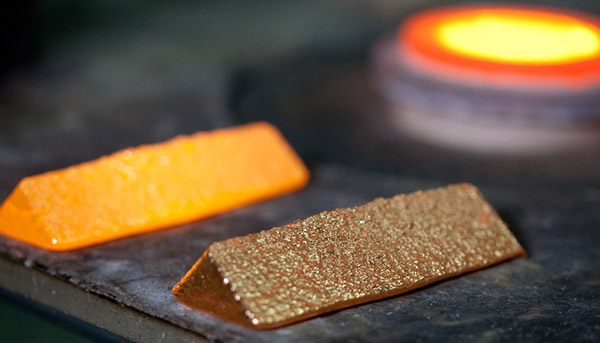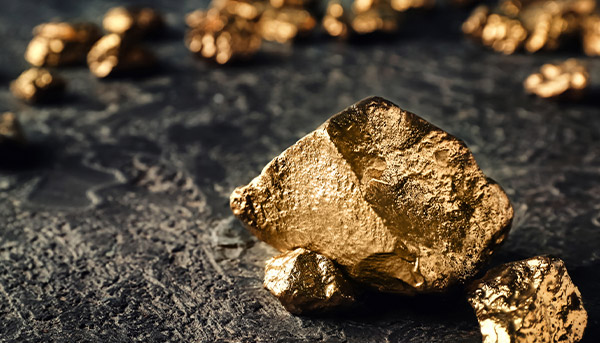
Journey of Gold – How gold is made
Key Takeaways:
- Gold occurs in the range of 0.001 and 0.006 parts per million in the Earth’s crust and is classified as “primary” or “secondary” deposits.
- Modern gold mining techniques are more energy-intensive, including sluicing, dredging, open-pit mining, and underground mining.
- Gold mining can have negative environmental impacts, including water pollution and significant waste generation.
- Gold mining can contribute to economic growth, creating direct and indirect jobs, and attracting foreign direct investment.
Gold didn’t just appear from nowhere. Instead, it formed in the cataclysmic interiors of former stars billions of years ago, like all other heavy elements found on Earth (except helium, hydrogen and lithium). As hydrogen fusion failed in their cores, these ancient stars began to fuse increasingly heavy elements, up to and including a small quantity of gold.
Gold then travelled to us when these primordial stars went supernova. Asteroids and material in the early solar system’s accretion disc combined under gravity to create the Earth, giving it a small quantity of gold.
Today, gold occurs in the range of 0.001 and 0.006 parts per million in the Earth’s crust. However, this figure is an estimate. The precise quantity is unknown because of the depth and complexity of the planet’s outer shell.
Types Of Gold Deposits
Experts classify gold deposits into “primary” and “secondary” categories.
Primary deposits are locations where gold comes as part of quartz veins. Super-heated hydrothermal fluids from the mantle then push the metal towards the surface, flowing into rock crevices and settling there, ready for mining.
There are several variations of this process, describing gold formation:
- Superheated waters erupt from spring-like vents on the seafloor, bringing small quantities of gold, which mix with cold water and solidify on the seafloor.
- Hydrothermal fluids flow into fractures in the Earth’s crust as mountains rise from tectonic activity, depositing gold-rich quartz veins
- Ancient volcanic deposits in so-called “greenstone” belts, a process that stopped around 2.3 billion years ago
- Chemical “invisible deposits” formed when hot gold-containing fluid underground mixes with sedimentary rock, producing a fine-particle gold-laden ore
In most parts of the Earth, gold comprises less than 0.5 grams per tonne. However, it can be as high as 2.5 grams in these “mountain gold” regions, making mining operations economically viable.
Primary gold-bearing mineral ores include gold-pyrrhotite, gold-fahlore, gold-polysulfide, and gold-telluride.
Secondary deposits result from millions of years of wind, water, ice and temperature weathering. These processes flush gold out of the underlying rock, producing small grains that gold panners and drillers can collect.
What Happens During The Gold Mining Process?

Miners attempt to remove gold from the ground at a minimal energy cost to preserve their margins. If they can extract an ounce of gold for less than the market rate, they make a profit.
Exploration
The first step in gold mining is exploration. Here, firms use various tools to estimate the density of gold deposits below the surface.
The simplest techniques involve observing gold-laden mineral veins or rock types known to contain gold at the surface. More complex operations require drilling into the subsurface and taking samples for laboratory analysis.
Extraction
The next step is extraction. If the gold is in a lode or vein deposit, miners usually dig shafts into the ground along the side of the vein. They then use a combination of picks and explosives to remove it. Conveyor belts or mine trucks then transport loose materials for refining.
For secondary mining operations, miners typically use hydraulic mining, power shovelling and dredging. These techniques help to collect gold nuggets washed downstream, rapidly sifting out unwanted sand or gravel.
Processing
Miners then wash the gold and ship it to mills. A rotating cylindrical vessel called a “ball mill” pulverises the gold-containing ore, making it easier to separate.
The last step is to separate gold particles from the rest of the material. Most miners achieve this via chemical methods. Some of these make it easier to skim gold particles off the top of any mixture, while others use processes that precipitate gold from ore using cyanide.
Finally, miners use melting techniques or electrolysis to achieve higher purities. These processes quickly remove any unwanted slag from the mixture, yielding pure gold. They can then use this to make gold bars, gold coins or gold jewellery.
What Mining Techniques And Tools Do Modern Gold Miners Use?
Historically, gold miners used primitive mining techniques, including panning and mining surface-level veins with picks. However, today they use more economical and energy-intensive methods, mainly because gold is less accessible than in the past.
Here’s a list of techniques used by modern miners in surface and underground mining:
- Sluicing – a sluice box is a tool that extracts gold from loose deposits by using riffles to create a “dead zone” where gold can drop out of the suspension.
- Dredging – dredging involves sucking material from the bottom of a river or lake using a suction hose attached to a pontoon-mounted sluice box.
- Open-pit mining – the most popular gold-mining process globally where miners dig down at the surface and extract the metal from loose sediments.
- Underground mining – where miners dig deep tunnels underground to access veins and lodes.
What Is The Environmental Impact Of Gold Mining?
The environmental impact of gold mining can be costly. Furthermore, most consumers aren’t aware of how it works. For example, gold production for a single wedding ring can produce over 20 tonnes of waste.
Poorly regulated gold mining can harm the environment in several ways, including:
- Poisoning waters by dumping toxic chemicals, such as lead, arsenic, mercury, and cyanide, in lakes and streams
- Generating millions of tonnes of solid, unusable ore waste
- Threatening natural areas, particularly in Indonesia, Ghana, and the U.S., that play host to high biodiversity
How Important Is Gold Mining Economically, And What Role Does It Play In Global Trade?
Gold mining comprises a significant portion of output in many developing nations and can contribute to economic growth. According to some researchers, it creates direct and indirect jobs and attracts valuable foreign direct investment.
Gold mining companies are often set up in remote locations, providing a source of livelihood for people living nearby. Firms may also improve local roads, energy infrastructure, and water supplies to facilitate their operations. Therefore, the economic benefits of gold mines often outlive their operational lifetime.

+ There are no comments
Add yours